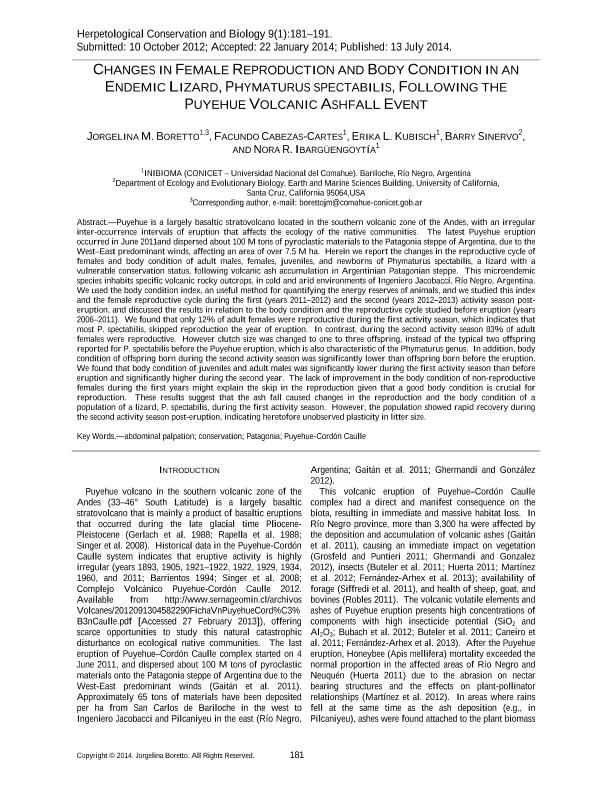Artículo
Changes in female reproduction and body condition in an endemic lizard, Phymaturus Spectabilis, following the Puyehue volcanic ashfall event
Boretto, Jorgelina Mariela ; Cabezas, Facundo
; Cabezas, Facundo ; Kubisch, Erika Leticia
; Kubisch, Erika Leticia ; Sinervo, Barry; Ibarguengoytía, Nora
; Sinervo, Barry; Ibarguengoytía, Nora
 ; Cabezas, Facundo
; Cabezas, Facundo ; Kubisch, Erika Leticia
; Kubisch, Erika Leticia ; Sinervo, Barry; Ibarguengoytía, Nora
; Sinervo, Barry; Ibarguengoytía, Nora
Fecha de publicación:
07/2014
Editorial:
Herpetological Conservation and Biology
Revista:
Herpetological Conservation and Biology
ISSN:
1931-7603
Idioma:
Inglés
Tipo de recurso:
Artículo publicado
Clasificación temática:
Resumen
Puyehue is a largely basaltic stratovolcano located in the southern volcanic zone of the Andes, with an irregular inter-occurrence intervals of eruption that affects the ecology of the native communities. The latest Puyehue eruption occurred in June 2011and dispersed about 100 M tons of pyroclastic materials to the Patagonia steppe of Argentina, due to the West–East predominant winds, affecting an area of over 7.5 M ha. Herein we report the changes in the reproductive cycle of females and body condition of adult males, females, juveniles, and newborns of Phymaturus spectabilis, a lizard with a vulnerable conservation status, following volcanic ash accumulation in Argentinian Patagonian steppe. This microendemic species inhabits specific volcanic rocky outcrops, in cold and arid environments of Ingeniero Jacobacci, Río Negro, Argentina. We used the body condition index, an useful method for quantifying the energy reserves of animals, and we studied this index and the female reproductive cycle during the first (years 2011–2012) and the second (years 2012–2013) activity season posteruption, and discussed the results in relation to the body condition and the reproductive cycle studied before eruption (years 2006–2011). We found that only 12% of adult females were reproductive during the first activity season, which indicates that most P. spectabilis, skipped reproduction the year of eruption. In contrast, during the second activity season 83% of adult females were reproductive. However clutch size was changed to one to three offspring, instead of the typical two offspring reported for P. spectabilis before the Puyehue eruption, which is also characteristic of the Phymaturus genus. In addition, body condition of offspring born during the second activity season was significantly lower than offspring born before the eruption. We found that body condition of juveniles and adult males was significantly lower during the first activity season than before eruption and significantly higher during the second year. The lack of improvement in the body condition of non-reproductive females during the first years might explain the skip in the reproduction given that a good body condition is crucial for reproduction. These results suggest that the ash fall caused changes in the reproduction and the body condition of a population of a lizard, P. spectabilis, during the first activity season. However, the population showed rapid recovery during the second activity season post-eruption, indicating heretofore unobserved plasticity in litter size.
Palabras clave:
Abdominal Palpation
,
Conservation
,
Patagonia
,
Puyehue-Cordón Caulle
Archivos asociados
Licencia
Identificadores
Colecciones
Articulos(INIBIOMA)
Articulos de INST. DE INVEST.EN BIODIVERSIDAD Y MEDIOAMBIENTE
Articulos de INST. DE INVEST.EN BIODIVERSIDAD Y MEDIOAMBIENTE
Citación
Boretto, Jorgelina Mariela; Cabezas, Facundo; Kubisch, Erika Leticia; Sinervo, Barry; Ibarguengoytía, Nora; Changes in female reproduction and body condition in an endemic lizard, Phymaturus Spectabilis, following the Puyehue volcanic ashfall event; Herpetological Conservation and Biology; Herpetological Conservation and Biology; 9; 1; 7-2014; 181-191
Compartir



